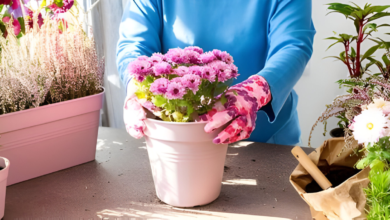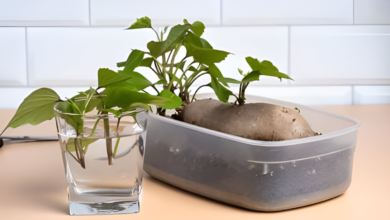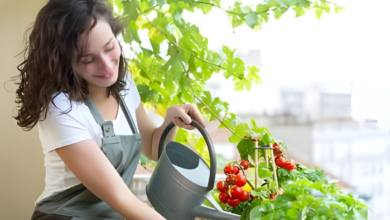Create a Very Easy Flower Pot: DIY Gardening Delight

Introduction
DIY gardening is a rewarding and fulfilling hobby that allows you to reconnect with nature and unleash your creativity. One of the key elements in any garden is the flower pot, as it not only holds your plants but also enhances the overall aesthetics of your outdoor space. In this blog post, we will guide you through the process of creating a very easy flower pot, providing tips on gathering supplies, preparing the pot, planting flowers, nurturing your pot, and even harvesting and repotting. Get ready to embark on a delightful gardening journey that will bring beauty and joy to your surroundings.
I. Gathering Supplies
Before we jump into creating the flower pot, let’s gather the essential supplies that will ensure successful gardening.
A. Essential Materials
To create a flower pot, you will need the following materials:
- Terracotta pot
- Garden trowel
- Watering can or hose
- Hand rake or cultivator
- Gardening gloves
B. Choosing the Right Potting Soil
Choosing the right potting soil is crucial for the health and growth of your flowers. Opt for a high-quality potting mix that is well-draining and rich in nutrients. Look for a blend that contains a combination of peat moss, vermiculite, and perlite.
C. Selecting Suitable Flower Seeds
Choose flower seeds that are suitable for your climate and the amount of sunlight your flower pot will receive. Consider factors such as bloom time, color, and height to create a visually appealing and harmonious arrangement of flowers in your pot.
II. Preparing the Flower Pot
Now that we have gathered our supplies, it’s time to prepare the flower pot for planting.
A. Cleaning and Sterilizing the Pot
Before use, it’s important to clean and sterilize the flower pot to remove any dirt, debris, or potential disease-causing organisms. Simply wash the pot with warm water and mild soap, scrubbing gently to ensure a thorough cleaning. Once clean, rinse the pot thoroughly and allow it to air dry.
B. Creating Drainage Holes
Proper drainage is essential for the health of your plants, as it prevents water from accumulating and causing root rot. Using a drill or a sharp object, carefully create a few drainage holes at the bottom of the pot. These holes will allow excess water to escape, keeping the soil well-drained and promoting healthy growth.
C. Enhancing the Pot’s Aesthetics
If you want to add a personal touch to your flower pot, consider enhancing its aesthetics. You can paint the pot with vibrant colors or designs, add decorative elements such as ribbon or mosaic tiles, or even personalize it with your name or a motivational quote. Let your creativity shine and make your flower pot a true reflection of your personality.
III. Planting Your Flowers
With the flower pot prepared, it’s time to plant your chosen flowers and bring life and color to your garden space.
A. Preparing the Soil Mix
Before planting, prepare a suitable soil mix by combining the potting soil with a slow-release fertilizer. This will provide your flowers with the necessary nutrients to thrive. Follow the instructions on the fertilizer packaging for the correct ratio.
B. Planting Techniques for Different Flowers
Different flowers have different planting techniques. Some flowers need to be sown directly into the soil, whereas others require starting indoors and transplanting later. Refer to the seed packaging or do a little research to ensure you are planting your flowers correctly. Be mindful of spacing, as overcrowding can lead to poor growth and competition for nutrients.
C. Proper Watering and Sunlight Requirements
Water your flowers with care, allowing the soil to dry slightly between waterings. Overwatering can lead to root rot, while underwatering can cause the flowers to wilt. Additionally, ensure your flower pot receives adequate sunlight, as most flowers require at least six hours of direct sunlight daily. Pay attention to the specific sunlight requirements of the flowers you have chosen and place your pot accordingly.
IV. Nurturing Your Flower Pot
To help your flowers thrive, it’s important to provide them with regular care and attention.
A. Regular Maintenance Tips
Regular maintenance is crucial for the health of your flower pot. This includes removing dead flowers and leaves, pruning overgrown branches, and ensuring proper air circulation by thinning out the plants if necessary. Regularly inspect your flower pot for any signs of pests or diseases and take prompt action to prevent any infestations.
B. Fertilizing Schedule
To keep your flowers nourished, follow a regular fertilizing schedule. Apply a balanced, water-soluble fertilizer once every two weeks during the growing season. Be sure to follow the instructions on the fertilizer packaging for the correct dosage and application method.
C. Dealing with Common Pests and Diseases
Pests and diseases can pose a threat to your flowers. Keep an eye out for common problems such as aphids, snails, or powdery mildew. There are various organic and chemical methods available to combat these issues, depending on your preference and the severity of the problem. Research the best solutions for the specific pests or diseases you encounter.
V. Harvest and Repotting
As your flowers flourish, there will come a time when they are ready to be harvested and potentially repotted for continued growth.
A. Knowing When to Harvest Flowers
Each flower has its own optimal time for harvesting. Keep an eye on the blooms and look for signs such as vibrant color, firm petals, and a fresh fragrance. Harvesting at the right time ensures maximum enjoyment and lifespan for your flowers.
B. Propagation Techniques
If you want to expand your garden, consider propagating your flowers. This can be done through methods such as division, cutting, or layering. Research the specific propagation techniques that are suitable for the flowers you have grown.
C. Transferring Plants to Larger Pots
If your flowers outgrow their current pot, it’s time to transfer them to a larger one. Choose a pot that is one size larger and ensure it has proper drainage. Gently remove the plant from its original pot, taking care not to damage the roots, and place it in the new pot. Fill the gaps with fresh potting soil and water thoroughly.
VII. Summary
In summary, creating a very easy flower pot is a delightful DIY gardening project that anyone can enjoy. By gathering the necessary supplies, preparing the flower pot, planting the flowers, nurturing the pot, and utilizing proper harvesting and repotting techniques, you can create a beautiful and thriving garden space. DIY gardening not only provides numerous benefits, but it also serves as a creative outlet that allows you to connect with nature and express your own unique style.
VIII. Frequently Asked Questions (FAQs)
To address some common queries, here are answers to frequently asked questions about creating and maintaining flower pots:
A. Can I reuse an old container as a flower pot?
Yes, you can certainly reuse old containers as flower pots. However, ensure that they are thoroughly cleaned and sterilized before planting to prevent the transfer of any diseases or pests.
B. How often should I water my flowers?
The watering frequency for flowers varies depending on factors such as weather, plant type, and pot size. As a general rule, water your flowers whenever the top inch of soil feels dry. Monitor the moisture levels closely, taking care not to overwater or submerge your plants.
C. Can I grow multiple types of flowers in one pot?
Yes, you can grow multiple types of flowers in one pot, provided they have similar sunlight and water requirements. However, be mindful of spacing and ensure that each plant has enough room to grow and access the necessary nutrients.




